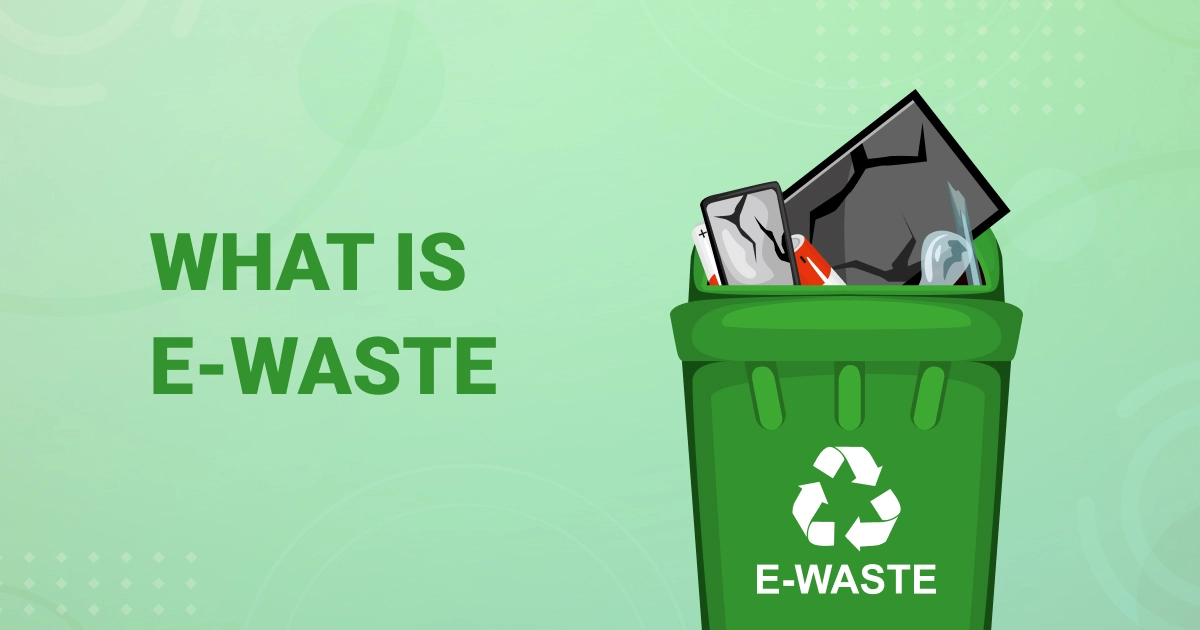In an era of rapidly advancing technology, it’s easy to lose sight of the electronic devices we replace. Then what happens when our gadgets complete their life cycle and end up in the landfill? What is electronic waste? Let’s delve into the world of e-waste and its impact on our environment and health while also exploring the potential solutions and best practices for e-waste management.
Defining E-Waste: Unwanted Electronic Devices
E-waste refers to discarded electronic equipment covering a broad spectrum of items, including televisions, computers, cell phones, and other similar devices.
These devices, when they become unwanted or reach the end of their useful life, become part of the e-waste stream.
When these devices are not properly disposed of, they pose significant environmental and health risks.
The Environmental Protection Agency estimates that tons of electronic waste are generated annually, with only a tiny fraction being formally recycled. The rest is often dumped in landfills or incinerated, releasing toxic substances into the environment. These discarded devices contain hazardous materials that can contaminate soil, water, and air, posing environmental and health hazards.
The Growing E-Waste Problem
Several factors contribute to the escalating hazardous waste issue. One of the main contributors to the growing e-waste pollution is the rapid advancement of technology. As newer, more advanced models of devices are released, older models quickly become obsolete.
Regrettably, many of these discarded electronics are still in perfect working condition. However, the appeal of new features in updated models fosters a culture where functioning electronics are rapidly considered outdated and disposed of. This premature electronic waste generation exacerbates the problem, filling landfills with valuable materials like precious metals that could otherwise be reused or recycled.
Toxic Chemicals in E-Waste: Risks to Human Health and the Environment
Electronics are complex devices made up of numerous materials. While many of these materials are harmless, there are also dangerous substances present in these devices. Electronic waste typically contains toxic materials such as beryllium, cadmium, mercury, etc.
When the discarded devices are improperly managed, these harmful substances have the potential to pollute our environment as hazardous waste. Toxic materials can contaminate soil, water, and air, posing health problems due to inhaling toxic fumes and the buildup of chemicals in the environment. These risks are notably elevated in developing countries, which often receive e-waste from developed nations, leading to substantial health hazards for individuals involved in handling or residing near e-waste.
The leaching process results in these toxic waste materials dissolving into the ground, contaminating groundwater. This presents a significant environmental risk and further underscores the need for proper e-waste management.

E-Waste Management: Current Challenges and Inefficiencies
Despite increasing awareness about the issue, current electronic waste management practices face numerous challenges. The primary inefficiencies in the existing recycling processes for e-waste encompass challenges in the:
- Collection;
- Sorting;
- Prevention of further waste;
- Emissions;
- Material contamination;
- Lack of awareness;
- High costs.
These challenges are compounded by ethical considerations, particularly concerning the export of e-waste to countries with insufficient labor regulations. This could result in:
- the exploitation and harm of workers in those areas;
- unsafe working conditions;
- exposure to hazardous materials;
- health risks for workers and local communities.
Moreover, the inhomogeneity and low energy density of e-waste present obstacles to its environmentally sound management. These challenges highlight the necessity for more efficient recycling operations and waste management strategies.
Responsible E-Waste Recycling: Benefits and Best Practices
Adopting responsible e-waste recycling practices can go a long way in mitigating the environmental and health impacts of e-waste. It involves extending the life of electronics, donating or repurposing unwanted electronics, and utilizing certified recycling facilities.
We’ll examine these practices in greater detail.
Extending the Life of Electronic Devices
One of the critical measures in preventing devices from turning into e-waste prematurely is to extend their lifespan. It can be achieved by delaying upgrades, conducting routine maintenance, and inquiring with manufacturers about return procedures for old devices.
Regular maintenance is vital for prolonging the lifespan of the device. These include regular cleaning to prevent ventilation issues, avoidance of extreme climate conditions, and strategic battery charging.
Additionally, postponing upgrades to consumer electronics can have profound environmental benefits. Extending the lifetime of electronic equipment minimizes the resources required for producing new devices, thus contributing to a reduction in e-waste generation.
Donating or Repurposing Unwanted Electronics
Another effective way to manage e-waste is donating or repurposing unwanted electronic devices. This gives these devices a new lease of life and prevents them from ending up in landfills.
For instance, you could donate your unwanted devices to reputable charities. Organizations like Call2Recycle, Earth911, and GreenerGadgets accept these donations and ensure they are correctly disposed of or recycled.
Utilizing Certified E-Waste Recycling Facilities
One of the most effective strategies for managing e-waste is to utilize certified recycling facilities. These facilities follow rigorous standards like R2, ensuring the implementation of top-notch practices in electronic waste recycling and the responsible management of e-waste.
In a certified e-waste recycling facility, the recycling process often involves:
- The collection of electronics;
- The separation of mixed e-waste;
- The removal of specific components;
- The destruction of data-bearing items like hard drives.
These facilities often provide Certificates of Destruction. It ensures that the e-waste is managed properly, preventing the release of toxic substances into the environment.
Certified data erasure is a crucial point of e-waste recycling as it provides securable annihilation of confidential information. To erase data quickly and efficiently from Apple and Android devices, use NSYS Data Erasure software. It is certified by ADISA and compliant with the NIST 800-88 attribution.

The Role of Manufacturers and Consumers in E-Waste Reduction
Both manufacturers and consumers play a significant role in the reduction of e-waste. Manufacturers can prioritize sustainable sourcing and transparent end-of-life processes for their electronic products.
On the other hand, consumers can mitigate e-waste by:
- Selecting products that are durable and repairable;
- Choosing products with extended lifespans;
- Opting for products made from recycled materials;
- Supporting products with a reduced environmental footprint;
- Endorsing companies that offer buyback programs or recycling services.
Built-in obsolescence greatly influences waste generation and complicates e-waste management, as it shortens the lifespan of electronic products. This underscores the need for both manufacturers and consumers to be mindful of their role in managing e-waste.
Innovative Solutions: Urban Mining and Secondary Supply Chains
Beyond conventional e-waste management practices, innovative solutions are being investigated to address the escalating global e-waste problem. One such solution is urban mining, which refers to extracting precious metals and minerals such as gold, silver, platinum, etc., from accumulated e-waste to reuse these resources, thereby preventing their disposal in landfills.
The establishment of secondary supply chains represents another innovative solution. Secondary supply chains are crucial in establishing sustainable cycles by ensuring that mined metals are recycled and reused to produce new devices. Moreover, they reduce the reliance on freshly mined materials.
Summary
In conclusion, understanding e-waste and its implications is crucial in our technologically driven world. From defining e-waste to exploring the contributing factors, health and environmental risks, management challenges, and best practices, we’ve delved into the complexities of this issue. We’ve also looked at the roles of manufacturers and consumers in reducing e-waste and the innovative solutions being explored.
It’s clear that managing e-waste requires a concerted effort from all stakeholders, and every step we take towards responsible e-waste management contributes to a more sustainable future.
Frequently Asked Questions
What is e-waste in simple words?
E-waste refers to unwanted electronic products like computers, televisions, and mobile phones, posing environmental and health risks if not properly disposed of and recycled.
What are the examples of e-waste?
Common examples of e-waste include computers, televisions, cell phones, and electronic toys. Remember to dispose of these items responsibly to prevent environmental harm.
Why is e-waste harmful?
E-waste is harmful due to toxic components like mercury, lead, cadmium, and flame retardants, which can cause damage to the brain, heart, liver, kidneys, and skeletal system. These toxins negatively affect humans and should be handled and disposed of properly.
How does e-waste contribute to environmental pollution?
E-waste contributes to environmental pollution by containing toxic materials that can contaminate soil, water, and air, posing risks to people's health and the environment, especially in developing countries.
How can we extend the life of electronic devices ?
To extend the life of devices and reduce e-waste, you can delay upgrades, conduct regular maintenance, and consider returning old devices to manufacturers for recycling. These steps help minimize environmental impact and promote sustainability.






